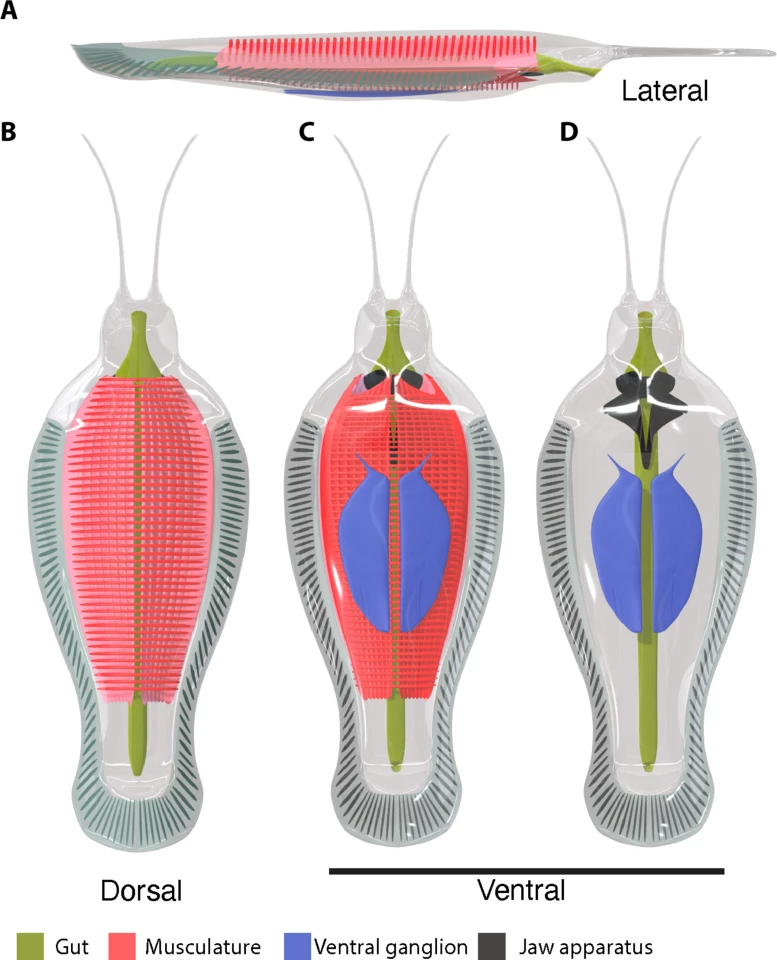Scientists have uncovered fossils detailing a new huge predatory worm species thought to have hunted in the Earth’s water column more than 518 million years ago.
Researchers from the University of Bristol's Schools of Earth Sciences and Biological Sciences believe this worm – named Timorebestia, or ‘terror beast’ in Latin – was one of the planet’s earliest carnivorous swimming animals and part of a diverse “dynasty” of predators that until now was unknown to scientists.
"We have previously known that primitive arthropods were the dominant predators during the Cambrian, such as the bizarre-looking anomalocaridids," said Jakob Vinther, a senior author on the study. "However, Timorebestia is a distant, but close, relative of living arrow worms, or chaetognaths. These are much smaller ocean predators today that feed on tiny zooplankton."

The fossils, which were found in the Early Cambrian Sirius Passet region in North Greenland, revealed that the Timorebestia also sported fins along the sides of its body, a massive jaw inside its mouth and long antennae. While its 30-cm length may not fit the picture of the ‘terror beast’ name the worm has been given, at the time Timorebestia would have been one of the largest swimmers.
"Our research shows that these ancient ocean ecosystems were fairly complex, with a food chain that allowed for several tiers of predators,” said Vinther. "Timorebestia were giants of their day and would have been close to the top of the food chain. That makes it equivalent in importance to some of the top carnivores in modern oceans, such as sharks and seals back in the Cambrian period."
The fossilized digestive system gave the researchers clues to the worm’s diet, with remnants of a swimming arthropod – the extinct bivalved Isoxys – identified.
"We can see these arthropods were a food source for many other animals," said Morten Lunde Nielsen, a former researcher at Bristol and part of the study. "They are very common at Sirius Passet and had long protective spines, pointing both forwards and backwards. However, they clearly didn't completely succeed in avoiding that fate, because Timorebestia munched on them in great quantities."
Their closest living relative, chaetognaths, are generally less than 1 cm in length and feed on tiny zooplankton.
"Both arrow worms, and the more primitive Timorebestia, were swimming predators,” said Vinther. “We can therefore surmise that in all likelihood they were the predators that dominated the oceans before arthropods took off. Perhaps they had a dynasty of about 10-15 million years before they got superseded by other, and more successful, groups."

Timorebestia can also offer important clues as to how arrow worms evolved. Arrow worms may not have the internal jaw of its relative, but they do have swimming fins that run along their body and a distinctive head decorated with spikes around their mouth to help capture prey.
"Timorebestia is a really significant find for understanding where these jawed predators came from,” said Luke Parry, from Oxford University, who was part of the study. “Today, arrow worms have menacing bristles on the outside of their heads for catching prey, whereas Timorebestia has jaws inside its head.
"This is what we see in microscopic jaw worms today – organisms that arrow worms shared an ancestor with over half a billion years ago,” he added. “Timorebestia and other fossils like it provide links between closely related organisms that today look very different."
But, like with much evolutionary biology, a lot of the really interesting connections lie beneath the surface. In this case, a unique nerve center that the Timorebestia looked to have in common with arrow worms furthers the scientists’ belief that they’re the small species’ ‘giant’ ancestor.
"Our discovery firms up how arrow worms evolved," said Tae Yoon Park from the Korean Polar Research Institute, a senior author of the study. "Living arrow worms have a distinct nervous center on their belly, called a ventral ganglion. It is entirely unique to these animals.
"We have found this preserved in Timorebestia and another fossil called Amiskwia,” he added. “People have debated whether or not Amiskwia was closely related to arrow worms as part of their evolutionary stem lineage. The preservation of these unique ventral ganglia gives us a great deal more confidence in this hypothesis."
"We have many more exciting findings to share in the coming years that will help show how the earliest animal ecosystems looked like and evolved,” he said.
The study was published in the journal Science Advances.
Source: University of Bristol






